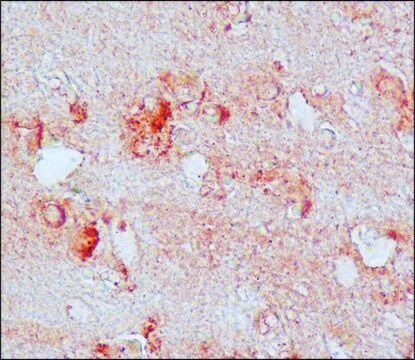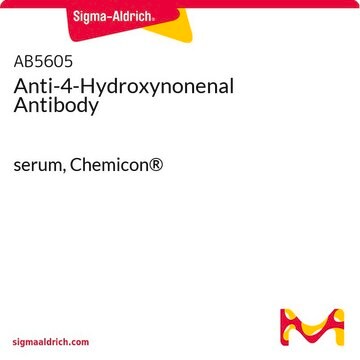487923
Anti-Nitrotyrosine Mouse mAb (CC22.8C7.3)
liquid, clone CC22.8C7.3, Calbiochem®
Sign Into View Organizational & Contract Pricing
Select a Size
All Photos(1)
Select a Size
Change View
About This Item
UNSPSC Code:
12352203
NACRES:
NA.41
Recommended Products
biological source
mouse
Quality Level
antibody form
purified antibody
antibody product type
primary antibodies
clone
CC22.8C7.3, monoclonal
form
liquid
contains
≤0.1% sodium azide as preservative
species reactivity (predicted by homology)
all
manufacturer/tradename
Calbiochem®
storage condition
OK to freeze
avoid repeated freeze/thaw cycles
General description
Purified mouse monoclonal antibody. Recognizes nitrotyrosine-containing proteins.
Recognizes nitrotyrosine.
This Anti-Nitrotyrosine Mouse mAb (CC22.8C7.3) is validated for use in Immunoblotting for the detection of Nitrotyrosine.
Immunogen
peroxynitrite-treated KLH
Application
Immunoblotting (2 µg/ml)
Warning
Toxicity: Standard Handling (A)
Physical form
In PBS, 50% glycerol, 0.1% BSA, 0.02% sodium azide, pH 7.2.
Reconstitution
Reconstitute with H₂O to a final stock concentration of 1 mg/ml. Following reconsitution, aliquot and freeze (-20°C). Avoid freeze/thaw cycles of solutions.
Analysis Note
Positive Control
Mouse macrophages treated with peroxynitrite
Mouse macrophages treated with peroxynitrite
Other Notes
Myatt, L., et al. 1996. Hypertension28, 488.
Beckman, J.S., et al. 1994. Biol. Chem. Hoppe-Seyler375, 81.
Beckman, J.S., et al. 1994. Biol. Chem. Hoppe-Seyler375, 81.
Variables associated with assay conditions will dictate the proper working dilution.
Legal Information
CALBIOCHEM is a registered trademark of Merck KGaA, Darmstadt, Germany
Not finding the right product?
Try our Product Selector Tool.
Storage Class Code
10 - Combustible liquids
WGK
WGK 1
Flash Point(F)
Not applicable
Flash Point(C)
Not applicable
Certificates of Analysis (COA)
Search for Certificates of Analysis (COA) by entering the products Lot/Batch Number. Lot and Batch Numbers can be found on a product’s label following the words ‘Lot’ or ‘Batch’.
Already Own This Product?
Find documentation for the products that you have recently purchased in the Document Library.
Sanjeev Kumar et al.
The Journal of biological chemistry, 279(51), 53475-53482 (2004-10-01)
Plasmodium berghei invasion of Anopheles stephensi midgut cells causes severe damage, induces expression of nitric-oxide synthase, and leads to apoptosis. The present study indicates that invasion results in tyrosine nitration, catalyzed as a two-step reaction in which nitric-oxide synthase induction
Seungho Choi et al.
Neuroscience, 384, 41-53 (2018-05-22)
Alzheimer's disease (AD) is the most common form of dementia that is often accompanied by mood and emotional disturbances and seizures. There is growing body of evidence that neurons expressing γ-aminobutyric acid (GABA) play an important role in regulation of
Lalita Gupta et al.
Proceedings of the National Academy of Sciences of the United States of America, 102(11), 4010-4015 (2005-03-09)
In vivo responses of midgut epithelial cells to ookinete invasion of three different vector-parasite combinations, Aedes aegypti-Plasmodium gallinaceum, Anopheles stephensi-Plasmodium berghei, and A. stephensi-P. gallinaceum, were directly compared by using enzymatic markers and immunofluorescence stainings. Our studies indicate that, in
Teresa Tiago et al.
Biochemistry, 45(11), 3794-3804 (2006-03-15)
Exposure of myosin subfragment 1 (S1) to 3-morpholinosydnonimine (SIN-1) produced a time-dependent inhibition of the F-actin-stimulated S1 Mg(2+)-ATPase activity, reaching 50% inhibition with 46.7 +/- 8.3 microM SIN-1 for 8.7 microM S1, that is, at a SIN-1/S1 molar ratio of
Enrique Samper et al.
Free radical biology & medicine, 46(3), 387-396 (2008-11-29)
Lymphomas adapt to their environment by undergoing a complex series of biochemical changes that are currently not well understood. To better define these changes, we examined the gene expression and gene ontology profiles of thymic lymphomas from a commonly used
Our team of scientists has experience in all areas of research including Life Science, Material Science, Chemical Synthesis, Chromatography, Analytical and many others.
Contact Technical Service








